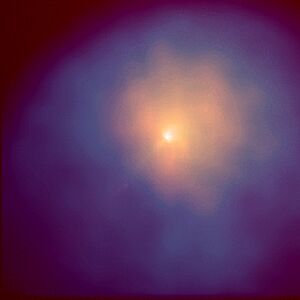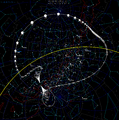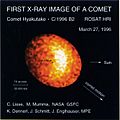Hyakutake facts for kids
Comet Hyakutake is a famous comet that visited our inner Solar System in 1996. It was a very bright comet, easy to see with just your eyes! It also had the longest comet tail ever found, stretching an incredible 500 million kilometers (about 310 million miles). That's longer than the distance from the Sun to Jupiter!
Contents
What is a Comet?
A comet is like a giant, dirty snowball flying through space. It's made of ice, dust, and rocks. When a comet gets close to the Sun, the ice heats up and turns into gas. This gas and dust form a huge cloud around the comet, called a coma. The Sun's wind then pushes this material away, creating the comet's amazing tail.
Comets orbit the Sun, just like planets. But their orbits are usually very long and stretched out. Some comets, like Hyakutake, only visit the inner Solar System once every thousands of years.
Discovery of Comet Hyakutake
Comet Hyakutake was discovered by a Japanese amateur astronomer named Yuji Hyakutake. He found it on January 30, 1996. He used a powerful pair of binoculars to spot it in the night sky. It was his second comet discovery in just a few weeks!
Hyakutake's Journey in 1996
Comet Hyakutake made its closest approach to Earth on March 25, 1996. It came within 15 million kilometers (about 9.3 million miles) of our planet. This was one of the closest comet approaches in 200 years! Because it was so close, it appeared very bright in the sky. Many people around the world were able to see it without a telescope.
The comet then continued its journey towards the Sun. It reached its closest point to the Sun, called perihelion, on May 1, 1996. After that, it began to travel away from the Sun and Earth.
Why Hyakutake Was Special
Comet Hyakutake was special for a few reasons:
- Incredibly Long Tail: As mentioned, it had the longest tail ever recorded. This tail was made of gas and dust pushed away by the Sun.
- Bright and Visible: Its close approach to Earth made it one of the brightest comets seen in decades. It was a spectacular sight for stargazers.
- X-ray Emission: Scientists were surprised to find that Comet Hyakutake was giving off X-rays. This was the first time X-rays had been detected from a comet. Scientists believe these X-rays are created when particles from the Sun's wind hit the comet's atmosphere.

Scientists used powerful telescopes, like the Hubble Space Telescope, to study Comet Hyakutake. They learned a lot about comets from this amazing visitor. They studied its nucleus (the solid core), its coma, and its tail.
Where is Hyakutake Now?
Comet Hyakutake is now traveling far away from the Sun. It is on a very long orbit that will take it thousands of years to complete. Scientists estimate it won't return to the inner Solar System for another 70,000 years or more! So, if you missed it in 1996, you'll have to wait a very, very long time for its next visit.
Images for kids
-
X-ray emission from Hyakutake, as seen by the ROSAT satellite.




